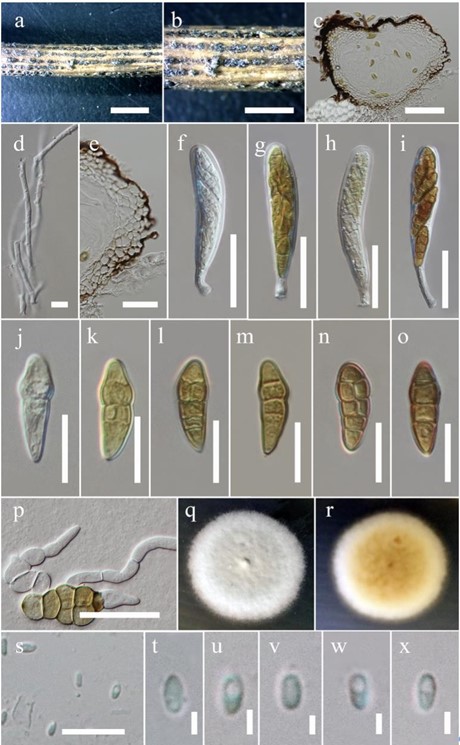Comoclathris galatellae D. Pem, T.S. Bulgakov & K.D. Hyde, sp. nov. Fig. 134
MycoBank number: MB 556799; Index Fungorum number: IF 556799; Facesoffungi number: FoF 07386.
Etymology – Name reflects the host from which the fungus is isolated. Holotype – MFLU 17-2454.
Saprobic or parasitic on Galatella villosa. Sexual morph: Ascomata 200–550 × 230–340 μm (x̅ = 205 × 235 µm, n = 10), immersed, erumpent to superficial, broadly to narrowly oblong and flattened, ostiolate. Ostiole papillate, dark brown to black, smooth. Peridium 10–30 μm thin, coriaceous, 1–2 layers, composed of dark-brown cells of textura angularis. Hamathecium comprising 1.8–3 μm wide, hyaline, septate, broad, dense pseudoparaphyses. Asci 50–90 × 14–17 µm (x̅ = 70.4 × 15.8 µm, n = 20), 8-spored, bitunicate, fissitunicate, cylindrical to clavate, with furcate pedicel and minute ocular chamber. Ascospores 20–30 × 6–8 µm (x̅ = 25.7 × 7.4 µm, n = 20), 1-seriate or partially overlapping, mostly ellipsoidal, brown or pale brown, muriform, 2–4 transverse septa, 1–2 longitudinal septa, without sheath. Asexual morph: Coelomycetous. Conidia 2–4 × 1–2 µm (x̅ = 3.8 × 1.4 µm, n = 20), oval to ellipsoid, hyaline, aseptate, guttulate, thin- or thick-walled.
Culture characteristics – Ascospores germinating on MEA within 24 h. Colonies growing on MEA, reaching 2 cm diam. in 1 week at 16 °C. Mycelium dense, circular, slightly raised, surface smooth, edge well-defined, thinly hairy, above whitish, reverse yellowish in the middle, whitish at the edge.
Material examined – Russia, Ukraine, Donetsk region, Donetsk city, Donetsk Botanical garden, steppe community, on dead branches of Galatella villosa (L.) Rchb.f. (Asteraceae), 17 May 2017, T.S. Bulgakov, DNK-032 (MFLU 17-2454, holotype) ex-type living culture MFLUCC 18- 0773.
Notes – Isolate MFLUCC 18-0773 was obtained from dead branches of Galatella villosa in Russia. This isolate clustered with the type isolate of Comoclathris permunda (MFLUCC 14-0974) with strong bootstrap support (98 % MLBS, 1.00 PP, Fig. 135). However, C. galatellae differs from C. permunda in having larger ascomata (200–550 × 230–340 μm vs 150–200 µm ×150–200 µm), shorter asci (50–90 × 14–17 µm vs 90–110 × 19–22 µm) and ascospores septation (2–4 transverse septa, 1–2 longitudinal septa vs. 3 transverse septa, 1 longitudinal septa). A comparison of 514 ITS (+5.8S) nucleotides between C. galatellae and C. permunda (MFLUCC 14-0974) shows 1.6 % base pairs difference. We introduce C. galatellae as a new species in Comoclathris based on morphological and DNA sequence data.

Figure 134 – Comoclathris galatellae (MFLU 17-2454, holotype). a Type material. b Appearance of black ascomata on the host. c Section of ascomata. d Hamathecium. e Peridium. f–i Asci with ascospores. j–o Ascospores. p Germinated ascospore. q, r Culture characteristics (q: above view; r: reverse view). s–x Conidia formed from culture. Scale bars: a = 2000 µm, b = 1000 µm, c = 50 µm, d, s = 10 µm, e = 40 µm, f–i = 50 µm, j–o = 20 µm, p = 50 µm, t–x = 2 µm.
